Numerical Studies on Drag Force and Wake-Affected Turbulence Modification of Combusting Droplets
Zhou Lixing,Li Ke(.Department of Engineering Mechanics,Tsinghua University,Beijing 00084,China;.School of Energy and Environment,Inner Mongolia University of Science and Technology,Baotou 0400,China)
Abstract:The drag force and wake-affected turbulence modification of combusting droplets/particles reflect the interaction between combustion droplets/particles and gas turbulence.For the effect of combustion on the particle drag force, it has been reported that combusting coal particles increase their drag force and combusting char particles reduce their drag force.For the drag force of combusting droplets, opposite experimental results of combustion enhancing or reducing the drag force have been reported, and in numerical simulations of spray combustion, the drag law for non-combusting solid particles is frequently adopted.As for the wake-affected turbulence modification,it is well known that larger solid particles enhance gas turbulence due to their wake effect, but the wake-affected turbulence modification of combusting droplets is still not clear.In this work, numerical studies are conducted for turbulent gas flows passing a single and multiple combusting droplets.The results indicate that the drag force of a combusting droplet is much smaller than that of a cold solid particle in isothermal flows, and the drag force of the combusting droplet group is also smaller than that of a single combusting droplet.In contrast to the enhancement ofturbulence caused by the solid particle’s wake effect, it is found that the wake effect of a single combusting droplet is turbulence reduction, and as the relative velocity of gas increases, the wake effect of the combusting droplet group first results in turbulence reduction and later turbulence enhancement.
Keywords:drag force;droplet combustion;turbulence;wake effect
Introduction
The drag force and wake-affected turbulence modification of combusting droplets/particles reflect the interaction between combustion droplets/particles and gas turbulence and are the important source terms in simulating turbulent two-phase combustion.To determine the effect of combustion on the particle drag force,Babii and Ivanova[1],many years ago,experimentally measured the velocity of a falling coal particle and reported that the drag force of a combusting coal particle is greater than that of a non-combusting solid particle in isothermal flows, but recent numerical studies by Farazi et al[2]reported opposite results,showing that the drag force of a combusting carbon particle is smaller than that of a non-combusting solid particle.Moreover,conflicting research results also exist for the drag force of combusting droplets.Makino and Fukada[3]measured the velocity of a single falling combusting sodium droplet,and their results show that when the droplet Reynolds number was less than 500,the combusting droplet drag coefficient was 2,whereas the drag force coefficient of the solid particle under isothermal condition was 0.44.However,Sugimoto[4]reported that the measured drag force coefficient of burning droplets in combusting methyl alcohol sprays decreased considerably compared with that of a solid particle in isothermal conditions.Presently,in the numerical simulation of spray combustion,the Wallis-Kliachko drag law for noncombusting solid particles is adopted.This treatment is questionable.For the wake-affected turbulence modification,it is widely recognized that the wake formation and vortex shedding behind larger solid particles enhance turbulence.Yuan and Michaelides[5]proposed a semi-empirical mechanistic model in which the velocity defect in the wake is responsible for the augmentation of gas turbulence.Yarin and Hetsroni[6]employed a similar idea to provide a more detailed description of the wake.Zaichik and Varaksin[7]studied the particle wake effect based on a simplified jet flow passing over a blunt body and proposed a model of particle wake effect using the method of turbulence modeling considering the mean velocity gradient in the particle wake.Yu and Zhou[8]proposed a turbulence enhancement model taking the particle diameter as a mixing-length.All these models are either lacking in application and detailed validation or the predicted results feature only qualitative agreement with the experimental results.Zeng and Zhou[9]proposed a model for wake-affected turbulence and added it to the gas Reynolds stress equations of gas-particle flows together with the ordinary particle-source term for simulating gas-particle pipe flows.The results indicated that the simulation that considered the particle wake effect better agreed with the experimental results than that in which the particle wake effect was not considered.As for combusting droplets,no studies on their wake-affected turbulence modification have been reported.In this work,numerical studies were conducted for turbulent gas flows passing a single combusting droplet and multiple combusting droplets.The aim of the study is to provide the drag force and wake-affected turbulence modification of combusting droplets and clarify the interaction between combustion droplets and gas turbulence using numerical results,in order to further construct new sub-models in the simulation of turbulent spray combustion.
1 Large eddy simulation of gas flows passing a single and multiple combusting droplets
For large eddy simulation(LES) of gas flows passing a single and multiple combusting droplets,the filtered governing equations are

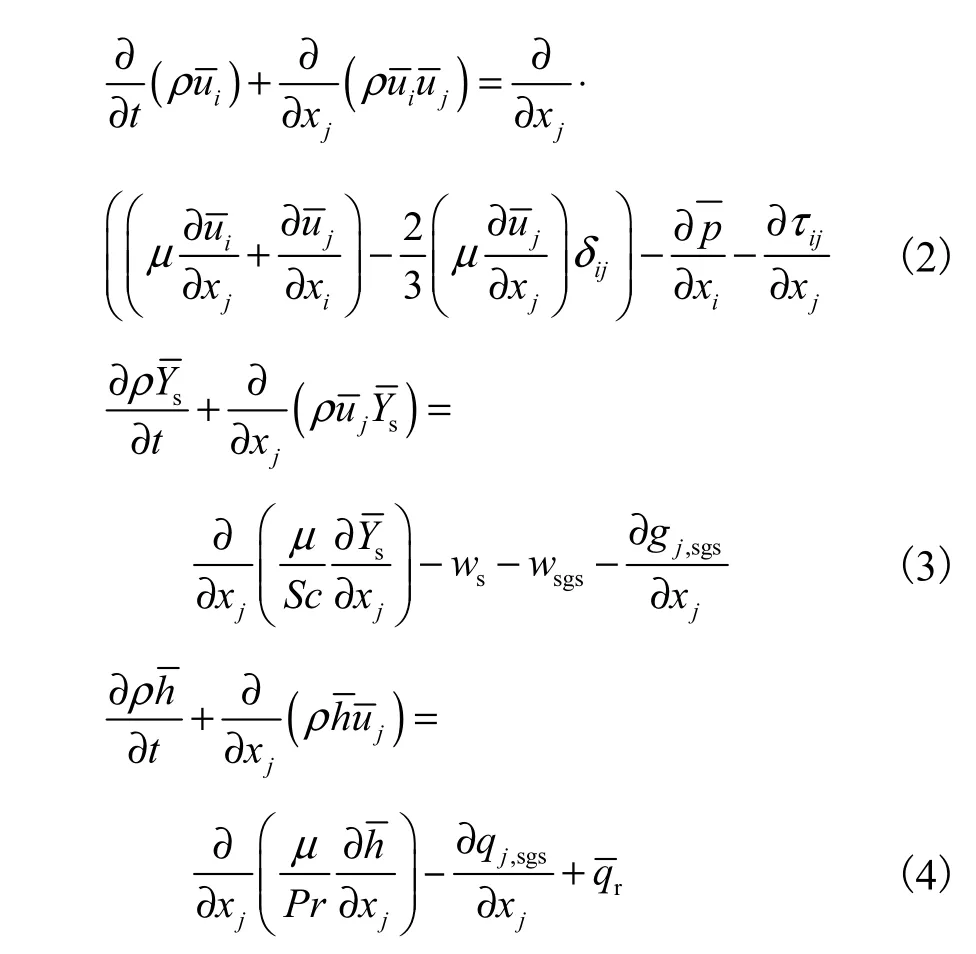
The boundary conditions at the gas-droplet interface are

where s=F(fuel),α=1;s≠F,α=0.
For the droplet ethanol-oxygen combustion,a finite-rate global reaction rate is used

The Arrhenius expression of the one-step global reaction kinetics for wsis

The Kim sub-grid scale energy equation model[10]is adopted for the sub-grid scale stressτij.
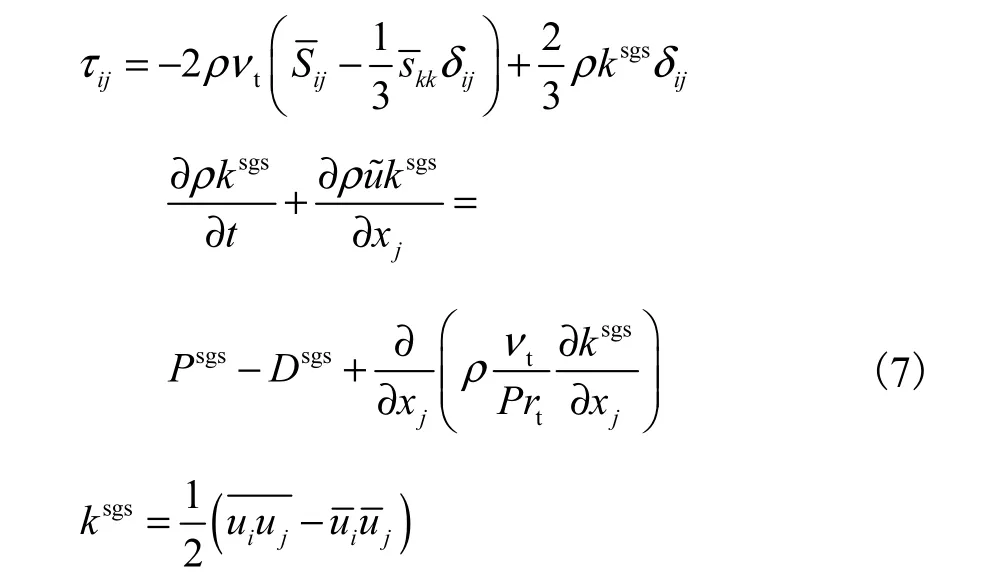
The computation domains are shown in Fig.1.For the simulation of a single combusting ethanol droplet,the grid sizes in x,y,and z directions were 10 μm to 400 µm;the time step was taken as 0.000 01 s and the grid number was 1 000 000.The pressure implicit with splitting of operators(PISO)algorithm was used for p-v corrections;the second-order implicit differencing scheme was used for the time-dependent term,and the quadratic upstream interpolation for convective kinematics differencing scheme was used for the convection and diffusion terms.For the simulation of multiple combusting ethanol droplets,the grid sizes in x,y,and z directions were 10 µm to 300 µm;the time step was taken as 0.000 001 s,and the grid number was about 1400000.The PISO algorithm was used for p-v corrections;the second-order implicit difference scheme was used for the time-dependent term,the second-order upwind differencing scheme was used for the convection term,and the central differencing scheme was used for the diffusion term.For the gas boundary conditions,uniform gas inlet velocity was assumed.The boundary condition at the exit was based on a fully developed flow assumption, where the gradients for all flow variables in the axial direction were 0.
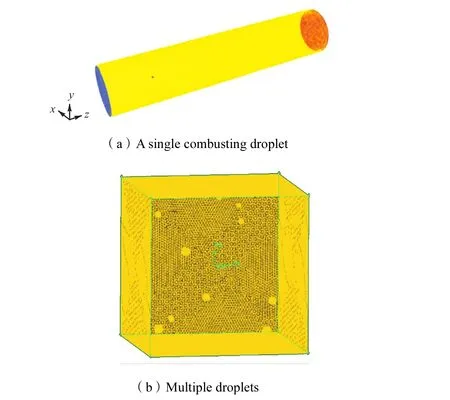
Fig.1 Computation domains for a single combusting droplet and multiple droplets
2 Simulated instantaneous results
For the single combusting droplet,Fig.2 presents the vorticity map and instantaneous temperature maps showing the wake structure.
Figure 3 shows the overlapped vorticity and temperature maps for the single combusting droplet.It is seen that a high temperature developed in the coherent structure region but not in the high-vorticity region adjacent to the droplet surface.The vorticity surrounding the droplet was much larger than that in other places.The vorticity for the fully enveloped flame was stronger than that for the wake flame.

Fig.2 Instantaneous vorticity map and temperature maps surrounding the single combusting ethanol droplet
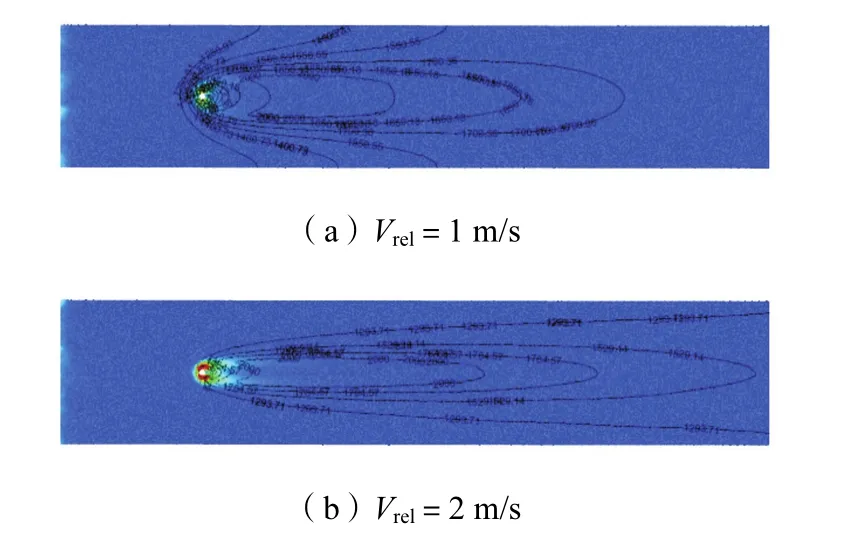
Fig.3 Overlapped vorticity and temperature maps of a combusting droplet(Tg=1 200 K;dp=1 000 µm)
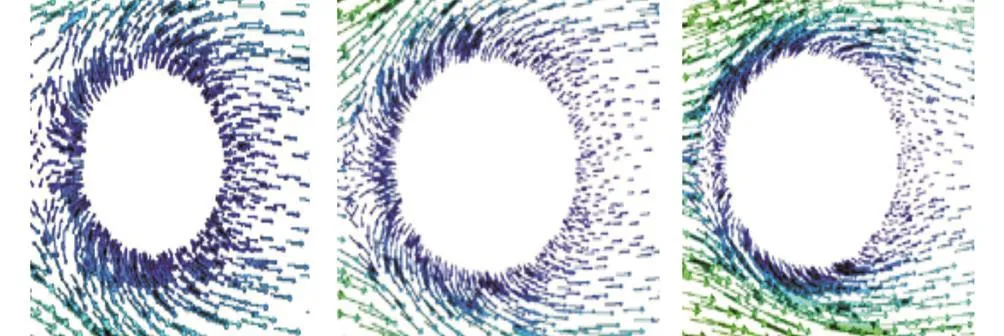
Fig.4 Velocity vectors surrounding three droplets
The illustrations of velocity vectors and vorticity maps surrounding three droplets(Fig.4 and 5)show that under the interaction among combusting droplets,the vorticities were not symmetrical and were different for the droplets at different locations.Moreover,the temperature maps surrounding the droplets in their group(Fig.6) show combustion modes different from that of the single droplet.

Fig.5 Vorticity maps surrounding three droplets

Fig.6 Temperature maps surrounding the droplet group
3 Drag forces of a single and multiple combusting droplets
The drag force of a single combusting droplet against that of a non-combusting solid particle,expressed by the Wallis-Kliachko formula[11],is presented in Tab.1.The Wallis-Kliachko formula for the drag force coefficient of a non-combusting solid particle is
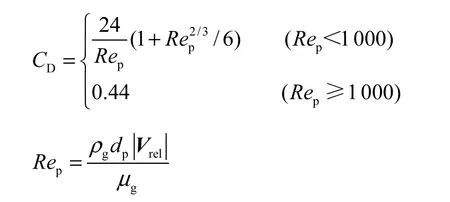
The drag force coefficient of the combusting droplet was significantly smaller than that of a solid particle.
The drag force coefficient combusting droplet in the droplet group against that of a single droplet is shown in Tab.2.As seen,the drag force of a droplet in the combusting droplet group was even smaller than that of a single combusting droplet.

Tab.1 Drag force coefficient of a single combusting droplet(dp=1 mm,Tg=1 200 K)

Tab.2 Drag force coefficient of combusting droplets
4 Wake-affected turbulence modification
Figure 7 illustrates the wake-affected turbulence modification of a single combusting droplet Δk=k1-k2(k1and k2are the turbulent kinetic energies before and behind the single combusting droplet,respectively).It can be seen that in contrast to the case of noncombusting solid particles,the combusting droplet reduced but not enhanced the gas turbulence;that is,the Stefan flux and non-isothermal effect reduce the gas turbulence.The turbulence modification increased with the increase of relative gas velocity.However,the wake-affected turbulence modification of combusting droplet group,given in Tab.3,was more complex than that of a single combusting droplet.As the gas relative velocity increased,the combusting droplet group first featured a reduction in turbulence,but as the relative of gas velocity reached 10 m/s, turbulence was enhanced.

Fig.7 Wake-affected turbulence modification of a single combusting droplet

Tab.3 Wake-affected turbulence modification of combusting droplet group
5 Conclusions
(1) The drag forces of a sigle combusting droplet and a combusting droplet group are much smaller than that of a non-combusting solid particle in isothermal condition.
(2) The wake effect of a single combusting droplet is turbulence reduction.
(3) The wake effect of a combusting droplet group is more complex than that of a single combusting droplet.With the increase of gas relative velocity,turbulence is first reduced and later enhanced.
More studies should be performed for obtaining new models of the drag coefficient and turbulence modification caused by the wake effect.
Nomenclature
CD—Drag coefficient;
dp—Droplet diameter;
D —Diffusion term;
g —Mass flux;
h —Enthalpy;
k —Turbulent kinetic energy;
p — Pressure;
Pr —Prandtl number;
q —Heat flux;
R — Universal gas constant;
r —Radial coordinate;
Re —Reynolds number;
Sc —Schmidt number;
t —Time;
T —Temperature;
u,v,V — Velocity;
w —Reaction rate;
x,y,z —Coordinate;
Y —Mass fraction.
Greek Alphabet
δ—Kronecker Delta;
λ—Heat conductivity;
μ—Dynamic viscosity;
ν—Kinematic viscosity;
ρ—Density;
τ—Shear stress.

